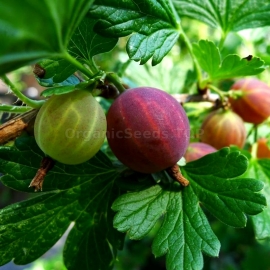


«Black Velvet» - Organic Gooseberry Seeds
2.00 €
Black Velvet is a mid season vigorous variety of gooseberry with a spreading habit. The berries are a dark red/plum colour with a pleasant mix of sweet and tart when ripe. Yields are high of small to medium sized fruits.
-
Органический крыжовник «Черный бархат»
Black Velvet — среднеспелый, энергичный сорт крыжовника с раскидистой кроной. Ягоды тёмно-красно-сливового цвета с приятным сочетанием сладкого и терпкого вкуса при созревании.
Урожайность высокая, плоды мелкие и средние. Если вы предпочитаете плоды покрупнее, проредите половину урожая, пока они незрелые, и используйте их в приготовлении пищи. Крыжовник «Черный бархат» содержит большое количество витамина С, а также некоторое количество витамина B6.
Он является богатым источником пищевых волокон, которые помогают улучшить здоровье желудочно-кишечного тракта. Богатый антиоксидантами, он используется для снижения уровня холестерина. Крыжовник также является источником кальция, железа и калия, которые полезны для снижения высокого кровяного давления.
Черный крыжовник — листопадный, колючий, многоствольный кустарник, произрастающий на Западном побережье. Весной он расцветает красивыми, похожими на фуксию, пурпурно-белыми цветами, а затем, когда созревают, появляются черные, сочные плоды.
Использование в пищу
Этот вид (divaricatum), пожалуй, самый вкусный дикий крыжовник на Западе; у него гладкая (а не колючая) кожура и приятный вкус. В свежем виде крыжовник обычно обладает уникальным, пикантным, терпко-сладким вкусом (что нравится некоторым). Он отлично подходит для приготовления джемов, пирогов, смузи и других ягодных сладостей.
Ягоды — отличный источник витамина С. Коренные народы Америки в этом регионе обычно ели чёрный крыжовник свежим, но иногда его готовили, делали из него сок, соус или сушили.
Декоративные качества
Главным декоративным достоинством чёрного крыжовника являются его пурпурно-белые цветы, напоминающие фуксию, которые свисают, словно изящные фонарики, на его изогнутых стеблях (он используется в европейских программах декоративной селекции). Листья также имеют приятную форму, напоминающую небольшой клён.
Однако его стебли (особенно молодые) покрыты множеством мелких щетинок и шипов. Хотя это может усложнить работу с растением, оно идеально подходит для создания «дикой» эстетики сада. Чёрный крыжовник отлично смотрится рядом с золотистой смородиной и чёрной малиной, а также под тихоокеанской дикой яблоней или иргой Саскатунской.
Окружающая среда и культура
В дикой природе чёрный крыжовник произрастает в редколесьях, среди прибрежных кустарников, на влажных склонах холмов и в прериях – почти исключительно на западной стороне Каскадных гор. Он предпочитает влажные или сырые почвы (выдерживает затопление) и хорошо растёт в пятнистой тени. Цветы привлекают местных колибри, а ягоды – множество птиц; кустарник обеспечивает места для гнездования и колючий покров.
Чёрный крыжовник – неприхотливое, легкое в выращивании многолетнее растение, отличное для экологичного сада. Он является одним из родителей нового сорта «Jostaberry» – гибрида крыжовника и смородины, выведенного в Университете штата Орегон.
Сбор урожая, уход и подготовка
Сбор черного крыжовника – это очень бережный процесс: нужно срывать свисающие черные ягоды с колючих стеблей. Рекомендуется надевать перчатки. Ягоды считаются спелыми, когда полностью почернеют и начнут размягчаться на ощупь. После сбора их можно есть свежими.
Или же приготовить из них разнообразные кулинарные шедевры, включая чатни, кетчупы и соусы к рыбе или мясу. А сладкоежки могут запечь из них ягодные пироги, коблеры или тарты. И
наконец, что не менее важно, крыжовник богат пектином и идеально подходит для джемов и желе, которыми можно наслаждаться всю зиму.
